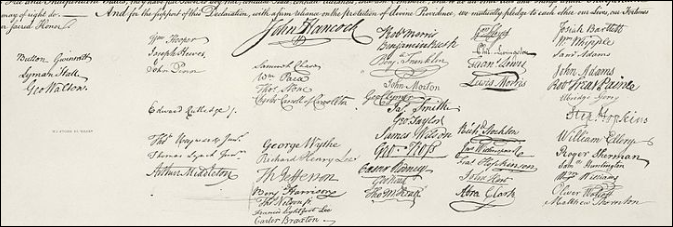An Examination Of Electronic Signatures And The Declaration Of Independence
By Karen Howe, Director of Training at Contract Logix
This week marks the Fourth of July holiday week in the U.S., the “hooray, we get an extra-long weekend because the Fourth comes on a Thursday this year” week. The holiday, of course, celebrates the adoption by the Second Continental Congress of the document declaring the thirteen colonies independent from Great Britain. Of the 56 signers of the Declaration of Independence, the most famous signature is “John Hancock” whose name has become synonymous with the act of signing your name to an important document.

And though the names of the signers are easily ascertained, the date the document was signed has incurred some debate. According to Wikipedia:
The final draft of the Declaration was approved by the Continental Congress on July 4, although the date of its signing has long been disputed. Most historians have concluded that it was signed on August 2, 1776, nearly a month after its adoption, and not on July 4 as is commonly believed…Subsequent research has confirmed that many of the signers had not been present in Congress on July 4 and that some delegates may have added their signatures even after August 2…Legal historian Wilfred Ritz concluded in 1986 that about 34 delegates signed the Declaration on July 4 and that the others signed on or after August 2.
In today’s digital world, the use of electronic signatures has become fairly widespread, especially when it comes to contract management software. After all, the ESIGN Act became federal law in 2000. So, I got to thinking, “What if our Founding Fathers had e-signature technology?”
Remote Signing without the Need to Print, Scan, Email
Well, first of all, it wouldn’t have required that all signatories gather in one location to sign one of the most important documents in U.S. history. As Wikipedia reports, some delegates “were attending to duties away from Congress when the signing took place”. Even In today’s world, with the advances of modern travel, company executives are frequently on the road and not available to sign in-person. With e-signature, they get an email with a link to the document which when clicked brings up an online copy to sign. They can sign from a computer or mobile device wherever they are – in the airport, at a client site or (and this may or may not be a good thing), while enjoying that 4th of July backyard barbecue with the family.
Automatic Signature Timestamp and Notifications
As far as the exact date of the signing of the Declaration, e-signature would have eliminated that controversy. Electronic signature applications take the guesswork out of who signed when by capturing the signing date along with the person’s signature. Since some contracts become effective on the date they’re signed, it’s important to have accurate information about the When as well as the Who. Plus, e-signature applications can also automatically manage notifications to the next signer and inform the person requesting the signatures when individuals have signed and when all requested signatures are complete. So, we’d know for sure when the Declaration was signed by all.
Better Control of Your Contract Process
Of course, in the contracting world, there are other benefits to going paperless with e-signature. You gain control of your entire contract process because you can track your contracts all the way from initial draft, through review and approval, to final execution, using system tools. How streamlined might the process of drafting, revising and getting agreement on the language of the Declaration have been if such tools were available?
Takeaway
Getting the Declaration of Independence drafted, approved and signed by all the delegates was no easy task, and as a contracting professional, you might feel that you face similar challenges. But with modern contract management tools like electronic signature, the job is much easier. So, when you’re watching those fireworks displays, don’t forget to think about how the world has changed since 1776. And have a safe and happy Fourth of July!


